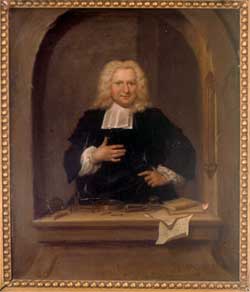<Back to Index>
- Physician and Physicist Pieter van Musschenbroek, 1692
- Composer Georg Philipp Telemann, 1681
- Queen Consort of Sweden and Norway Josephine of Leuchtenberg, 1807
PAGE SPONSOR
ΕΚΛΟΓΕΣ 2012
Τυπώστε και Ψηφίστε

Pieter van Musschenbroek (14 March 1692 – 19 September 1761) was a Dutch scientist. He was a professor in Duisburg, Utrecht, and Leiden, where he held positions in mathematics, philosophy, medicine, and astrology. He is credited with the invention of the first capacitor in 1746: the Leyden jar. He performed pioneering work on the buckling of compressed struts. Musschenbroek was also one of the first scientists (1729) to provide detailed descriptions of testing machines for tension, compression, and flexure testing. An early example of a problem in dynamic plasticity was described in the 1739 paper (in the form of the penetration of butter by a wooden stick subjected to impact by a wooden sphere).
Pieter van Musschenbroek was born on 14 March 1692 in Leiden, Holland, Dutch Republic. His father was Johannes van Musschenbroek and his mother was Margaretha van Straaten. The Van Musschenbroeks, originally from Flanders, lived in the city of Leiden since circa 1600. His father was an instrument maker, who made scientific instruments such as air pumps, microscopes, and telescopes.
Van Musschenbroek attended Latin school until 1708, where he studied Greek, Latin, French, English, High German, Italian, and Spanish. He studied medicine at Leiden University and received his doctorate in 1715. He also attended lectures by John Theophilus Desaguliers and Isaac Newton in London. And in 1719, he finished his study in philosophy.
In 1719, he became professor of mathematics and philosophy at the University of Duisburg. In 1721, he also became professor of medicine.
In 1723, he left his posts in Duisburg and became professor at the University of Utrecht. In 1732 he also became professor in astrology.
Musschenbroek's Elementa Physica (1726) played an important part in the transmission of Isaac Newton's ideas in physics to Europe. In November 1834 he was elected a Fellow of the Royal Society
In 1739, he returned to Leiden, where he succeeded Jacobus Wittichius as professor.
Already during his studies at Leiden University Van Musschenbroek became interested in electrostatics. At that time, transient electrical energy could be generated by friction machines but there was no way to store it. Musschenbroek and his student Andreas Cunaeus discovered that the energy could be stored in a glass jar filled with water into which a brass rod had been placed; and that the energy could be released only by completing an external circuit between the brass rod and another conductor, originally his hand, placed in contact with the outside of the jar. He communicated this discovery to René Réaumur in January 1746, and it was Abbe Nollet, the translator of Musschenbroek's letter from Latin, who named the invention the 'Leyden jar'.
Soon afterwards, it transpired that a German scientist, Ewald von Kleist, had independently constructed a similar device in late 1745, shortly before Musschenbroek.
In 1754, he became an honorary professor at the Imperial Academy of Science in Saint Petersburg. He was also elected a foreign member of the Royal Swedish Academy of Sciences in 1747.
Van Musschenbroek died on 19 September 1761 in Leiden.